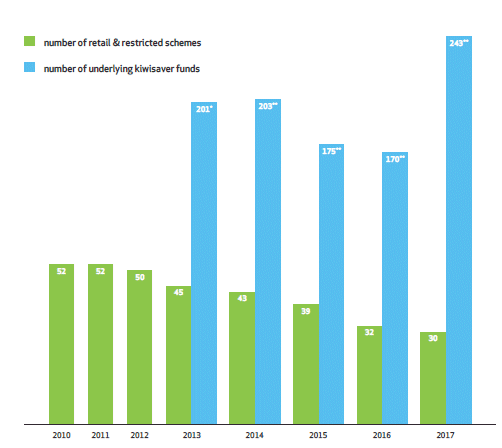Is more better, or just confusing?
In our new KiwiSaver column NZ Funds CIO Michael Lang asks whether we have too many KiwiSaver fund options available to investors.
Wednesday, June 6th 2018, 10:09AM
by Michael Lang

Most New Zealanders know that the sums invested in KiwiSaver have snowballed over the last 10 years. A lesser known fact is that the number of KiwiSaver investment funds being offered to the public has also multiplied.
KiwiSaver investment funds should not be confused with KiwiSaver schemes. These are the options each scheme offers. In fact, the number of KiwiSaver schemes has declined over the same period. The number of schemes peaked in 2010 at 52 and as at March 2017, stood at 30. And this included one which was closed to new members.
Why then do the number of funds continue to grow? An increasingly small number of schemes are offering an increasingly large number of funds. In total, the Financial Markets Authority (FMA) data lists over 240 underlying KiwiSaver funds.
AMP, for example, offers its clients a choice of 33 KiwiSaver funds. AMP is not alone in pursuing a menu based approach. Collectively, the top five organisations, ranked by number of funds on offer, offer 140 different funds.
This begs the question: Are more and more funds, offered by the same organisations, necessarily better? Any answer is likely to be subjective and almost certain to be contentious. Nevertheless, with an abundance of information available, some observations can be made.
First, up to a point, a range of different funds is useful, if not essential. Most New Zealanders see KiwiSaver as a retirement fund but an increasing number are initially using it to purchase their first home. 30,256 did so last year alone.
KiwiSaver can also be used as a source of emergency funding, which assisted 13,970 New Zealanders in the year ending June 2017.
Depending on which objective the investor has in mind, one fund may be more appropriate than another. For example, a lower risk income-orientated fund may be more appropriate for a first home purchase in the near future, whereas a higher risk, growth-orientated fund may better suit an individual working and saving for retirement in many years time.
Another good reason for offering a number of different funds is that the level of volatility individual investors are capable of withstanding differs depending on personal preference. This situation can be addressed by offering investors a choice of three schemes: a low, medium or higher risk scheme.
It is not surprising then that a number of large and successful managers, such as Kiwi Wealth and Milford, as well as smaller specialist managers like NZ Funds and newcomer Simplicity, offer their clients a limited choice of well diversified funds, each with a different level of risk.
This means that once investors decide which manager to work with, it is relatively easy to identify which fund is right for them.
In contrast, many of the Australian owned banks and insurance companies offer their clients a bewildering array of funds. Many of these funds are invested in only one type of investment or are restricted to being either onshore or offshore.
Such funds fly in the face of modern portfolio theory; the observation made by Markowitz in 1952 that owning a diversified portfolio of asset types enables investors to earn a higher level of return for the same level of risk.
One large Australian owned institution offers New Zealanders the opportunity to funnel their retirement savings into a small number of locally listed property securities, ten securities making up over 90% of the fund. Only 1,167 investors have taken up this opportunity.
Fortunately, with the help of an adviser, investors can diversify across other funds offered within the same scheme. However, it is not apparent how many have done so.
It could also be argued that this fund might provide a useful stepping stone onto the property ladder, but in 2009 when property prices temporarily dipped providing an excellent buying opportunity, the fund lost 25% of its value.
New Zealand might be better off with fewer funds but more providers offering diversified portfolios. The news that the Japanese owned conglomerate Sumitomo Corporation will offer a KiwiSaver scheme through its wholly owned subsidiary Nikko Asset Management is a positive step in this
direction.

* Data as at 30 September 2013, number of funds only relates to KiwiSaver schemes which are open to the public, Craigs Investment Partners KiwiSaver Select Scheme is assumed to be one fund for the
purpose of this analysis.
** Number of funds only relates to KiwiSaver schemes which are open to the public, Craigs Investment Partners KiwiSaver Select Scheme is assumed to be one fund for the purpose of this
analysis.
Michael Lang is Chief Executive at NZ Funds. New Zealand Funds Management is the issuer of the NZ Funds KiwiSaver Scheme.
| « Conservative attitude a bigger problem than fees: McLachlan | KiwiSaver incentives 'don't help those who need it most' » |
Special Offers
Comments from our readers
No comments yet
Sign In to add your comment
| Printable version | Email to a friend |


